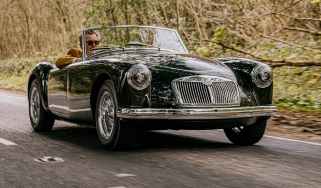evo Icons - Vauxhall Chevette 2300HS driven
A drive over the Route Napoleon in Southern France introduces us to one of Vauxhall's hidden historical gems
The proportions are faintly ludicrous. Approach from the front and, parked next to a modern Adam Grand Slam, the Vauxhall Chevette 2300HS looks impossibly tiny – low, with squinting rectangular headlights set deep in the nose and a square-edged bodykit at odds with the curvy bonnet.
Sitting down on a rock at the side of the road, I take a moment to study the side profile against the Alpine backdrop. From here, it’s also a car of two halves – nose-down stance, bulging tyres squeezed under blistered arches and blazing red stripes, contrasting with a dainty rump, flicked-up spoiler and pea-shooter exhaust.
At the rear, it’s completely cartoonish. A full third of the car’s height is occupied by the tyres; no deep bumper or fake diffuser to hide the haphazardly-welded sheet metal, below the same slim chrome bumper that buyers of the poverty-spec ‘L’ also enjoyed. Tape-deck style 'Vauxhall' script between the oblong light units drags an otherwise 70s form screaming into the next decade.
Were it not for Dealer Team Vauxhall – an organisation formed by a group of London-based Vauxhall dealers in 1971 - the 2300HS wouldn’t have existed in any decade.
At the time, GM-owned Vauxhall had no official motorsport division, yet in 1976, chairman Bob Price wanted to increase the firm’s profile in international rallying. DTV, along with engineering firm Blydenstein Racing, selected the humble Chevette to compete against the dominant Ford Escorts.
Chief among the group’s concerns was to raise power. Vauxhall’s first sixteen-valve engine, based on its existing slant-four iron block four, was the unit of choice. At 2279cc, it certainly had the capacity to out-punch Ford’s best efforts of the time. A pair of Stromberg carburettors liberated 135bhp at 5500rpm and 134lb ft of torque from 4500rpm. Walk into a Ford dealership that year, and 109bhp is the best an RS2000 could offer you.
A five-speed Getrag gearbox sent drive to the live rear axle, with an 8.8-second 0-60mph sprint the result – a useful tenth quicker than the Ford. Dagenham would be embarrassed further by the Chevette’s top speed of 117mph – a full 7mph quicker than the slant-nosed Escort.
Just one colour scheme was offered – silver, with a splash of red along the car’s flanks and across the rear panel. Double wishbones suspend the front, and an Opel Kadett GT/E-sourced live axle props up the rear. A Chevrolet Vega 6j x 13in alloy wheel sits under each arch, wrapped in chunky 205-section tyres, their protrudance beyond the standard arches accommodated by subtle flaring. Those arches would of course grow further with the blistered Chevette HSR in 1981, but the purity of the silver car’s flanks remains appealing.








